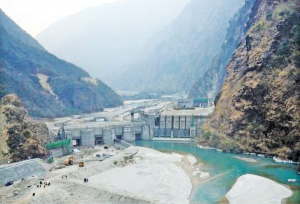In November 2021, India threw open its doors to purchase of Nepal’s electricity. This is an important milestone for Nepal as it the first time that the Himalayan country is exporting hydropower.
Nepal will export 39 MW of electricity to India under the Indian Energy Exchange (IEX). The India-Nepal Power Trade Agreement was signed in 2014 during Indian Prime Minister Narendra Modi’s visit to Nepal. Nepal is the first of India’s neighbors to participate in the IEX.
The sale of electricity to India marks the realization of a long-cherished Nepali dream of exporting hydroelectricity for national prosperity. This is a huge turnaround for the Nepali energy sector, which met more than half of its electricity needs through imports from India during peak demand in 2019.
Nepal became a power surplus country after the 456 MW Upper Tamakoshi Hydropower Project came into operation in July 2021. With this, Nepal’s hydroelectricity production has reached 1,900 MW. Meanwhile, the peak-hour demand stands at around 1,500MW only. On top of that, 172 projects have secured generation licenses and construction is ongoing for a total capacity of 4,642 MW. Therefore, the supply will outpace the local demand even further in the coming years.
In the meantime, in India the price of coal, which accounts for more than half of its energy generation, has increased and the economy is gathering momentum after the pandemic-related slowdown. This has increased the demand for energy in India.
The timing for the start of India-Nepal trade in hydroelectric power could not have been better for both countries. This seems to have created a natural synergy between the two countries. Without export, Nepal’s excess power would have gone to waste.
Nepali leaders have sold the dream of exporting electricity for prosperity for decades. Nepal has a theoretical potential of producing 83 GW of hydroelectricity.
The region is energy-starved; Nepal is surrounded by expanding energy markets, including India, Tibet, and Bangladesh. Therefore, some analysts view the start of Nepal’s export to India as a harbinger of the future energy trade in the region.
Environmentalists view this as a positive step for both Nepal and India as it could contribute to a reduction in carbon emissions. India has committed to carbon neutrality by 2070. It will not be able to achieve this target without replacing coal with renewable energy. The amount of power currently exported from Nepal may be insignificant but could grow to double-digits Gigawatt in the long term.
The potential of energy export is substantial. However, several issues merit attention.
Firstly, the current infrastructure does not support large-scale trade in power. Therefore, while developing additional hydropower projects, Nepal should collaborate with India to build an inter-nation transmissions line that can carry high voltage electricity. Such investment requires a stable policy platform and steady trade. Therefore, Nepal and India should prioritize long-term agreements with specified quantities and prices.
Secondly, India has permitted export of hydropower generated from only two projects. Both projects were built with New Delhi’s assistance. This stance is absurd and counterproductive. Electricity generated by any company in Nepal is integrated into the national grid and then distributed. The underlining message is that India wants to limit Chinese investment in Nepal’s hydropower sector. Negotiations are underway between Nepal and India to allow for energy trade generated by other companies.
Thirdly, Nepal is currently selling power to India at an average rate of 4.33 Nepali rupees (NRs.) ($0.036) per kWh. Nepal Electricity Authority buys the same electricity at NRs. 4.80 ($0.040) during monsoon (when the water flow in rivers is high) and NRs. 8.40 during winter (when the water level recedes) from the producers. Such trade is not feasible in the long term. Also, Nepali consumers and industries pay some of the highest tariffs for electricity. Therefore, selling to India at a cheap rate will limit Nepali industries’ competitiveness and create resentment.
Therefore, experts are calling for encouraging domestic consumption. Nepal’s per capita consumption of electrical power was 177 KWh in 2018 compared to the global average consumption of 3,349 KWh. The industrial sector will benefit immensely from the supply of stable power at a competitive rate. The government has adjusted the tariffs to encourage consumption.
Also, hydropower production can act as an economic multiplier if used to produce goods and services. There is hardly any example of a country that has gotten rich by selling power (except for naturally occurring fossil fuels), especially when the cost of production is very high.
Besides, Nepal should look to substitute fossil fuels. Fossil fuel (diesel, LPG, and petrol) are among its top four imports, accounting for $1.22 billion (12.5 percent of total imports) in 2020. Therefore, active policies to encourage the shift from gasoline to electricity would help Nepal achieve a higher quality of life and enable it to turn carbon neutral by 2040.
Hydropower export benefits Nepal. However, the country has to walk a fine line. It needs and has welcomed Chinese investment in hydroelectricity generation. At the same time it needs India for its market (even the power export to Bangladesh requires an Indian agreement). The balancing act will not be easy but promises big rewards.

































